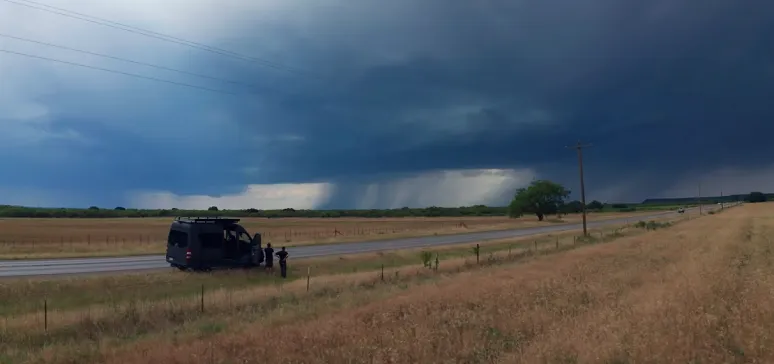This past March, along with countless other businesses and industries, numerous TV and film productions were forced to shut down when it became clear that COVID-19 was becoming a widespread health threat. National Geographic alone had to shut down nearly 77 productions in countries all over the world. Yesterday, at CTAM’s portion of the Television Critics Association press tour, held virtually this year, National Geographic Senior Vice President of Communications Chris Albert explained that it’s been equally as challenging for the network to get production back up and running. But audiences around the globe count on the network to share the narratives about cultures, wildlife, natural history, and social issues that are permeating societies all over the world. Of course, telling these stories requires production crews to travel and to get up, close, and personal, which, during a pandemic, can be problematic. During one of the network’s press tour panels, various showrunners shared the challenges they have encountered since getting back out on the field, and the additional health and safety measures they have taken while maintaining a high caliber of storytelling.
For Lisa Bloch, showrunner of the new series, Category Six, chasing the story is literally what her team does as they follow hurricanes and storms wherever they go. Bloch’s team went back into production in May and has had to carry the burden of navigating the complexities of pandemic and safety protocols in various states, while not losing sight of the hurricanes. “We, along with Nat Geo and Disney, are monitoring what’s happening in each state on a day-by-day, minute-by minute-basis,” said Bloch. “National Geographic has been amazing in working with us day and night to get the proper protocols in place and greenlight various shoots.”
“As part of the approval process when we vet each of our productions, we’re taking a look in real time the shoot locations that Category Six is going to,” said Michelle Upton, National Geographic Senior Vice President of Production Management. Upton also oversaw the network’s shutdown back in March. “We’re taking a look at whether COVID testing is needed; whether we need to quarantine crews; having health and safety managers on set and in the field; having teams work in small pods in order to keep everyone healthy and safe; and, that is our number one priority to keep all of our crews and talent healthy and safe.”
That being said, sometimes filming just can’t happen depending on a current state’s situation and regulations in place. Take, for example, the latest hurricane on the U.S. east coast this week. “You know, we just had been watching Hurricane Isaias going up the coast and turning into a tropical storm. And we were looking forward to chasing that from Florida up until New Jersey. But come New Jersey, we would have to stop. The storm would have to go on without us because New Jersey has a 14-day quarantine period if you’re coming from the state of Florida,” said Bloch.
Not to mention, crews have also faced the challenge of flying to locations and dealing with unexpected delays or rejections at airports, even after obtaining proper approvals and abiding by all necessary protocols. The problem comes from the rapid pace at which rules are changing, and gate attendants who haven’t been brought up to speed with the rules of their country, explained Jon Kroll, showrunner for Gordon Ramsay: Uncharted. “We knew we would have flights with masks and face shields and things like that to protect ourselves, but we didn’t know we would have so much confusion at each airport we stopped at,” said Kroll.
Fortunately, the territories where Kroll’s production crew films at are exactly what the show title references—uncharted—and that has worked to the crew’s advantage. The remoteness of the locations makes them relatively safe places, he said.
For Vanessa Berlowitz, executive producer of the natural history series, Queens, a big concern has risen from whether crew members could transmit COVID-19, unknowingly, to the wildlife they are filming. It’s not very realistic to expect curious monkeys to social distance from humans, she explained, and there’s not much anyone can do to prevent that. For this reason, the decision was made to cancel a shoot with bonobos in the Congo.
But the silver lining that has come throughout all of this for Berlowitz and her team is that the crew had already been working with female filmmakers from all over the world on how to shoot their own wildlife, and to promote their skills, since even before the pandemic started. “We actually had our series director of photography training a local Kenyan crew to film elephants giving birth in the spring … it was a really, really great season this year, and we were able to still achieve that filming without putting anyone’s safety at risk,” said Berlowitz.
As more productions move forward and learn to operate in a COVID world, National Geographic and Disney continue to work together to vet every production prior to going back out on the field. Upton explained that best practices, health and risk assessments, local and legal regulations regarding COVID testing, quarantining measures, PPE, daily temperature checks and health screening questionnaires, are all taking place. “And we’re in contact with [production crews] every couple of days, in addition to being on What’s App with them. So that’s how the network is ensuring that everybody is staying safe and healthy in such a challenging time.”
Header Image: Scene from National Geographic’s new series, ‘Category Six’









